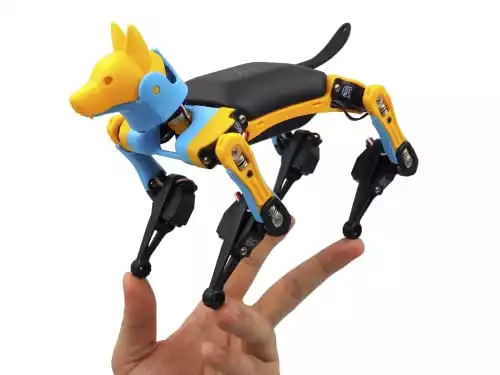Introduction
Humanity’s fascination with robotics has been a part of our culture for longer than you may think. Unfortunately, severe technical and cost barriers have been preventing the widespread adoption of robotics in everyday life. But, thanks to the increasing development of 3D printing technology, these barriers are beginning to dissolve as more people can get involved in robotics and experiment with creating functional devices.
This blog post will explore how 3D printing is accelerating the growth of robots. From soft actuators to new construction materials, 3D printing technology is revolutionizing the way we approach robotics.
Also Read: What is 3D Imaging and How Does it Work?
What is 3D Printed Robotics?
In order to grasp why 3D printing has become such a game-changing technology for robotics, it’s essential to understand what 3D printed robotics is. First, what is 3D printing? 3D printing creates three-dimensional objects through computer-aided design (CAD) or 3D modeling software. This technology works by layering molten plastic, metal, or other materials to create complex shapes with varying colors and textures.
The use of a 3D printer to create robots is no different. Rather than traditional methods of constructing robots, such as soldering, wiring, and bolting, 3D printing allows users to create entire robots with software-generated designs.
In terms of mechanical engineering, 3D printing of robotics is most useful for creating complex moving parts and for rapid prototyping and testing.
History of 3D Printed Robotics
The history of robots stretches back far into the past, with some of the earliest inventions dating back to Ancient Greece and Egypt. For instance, Pygmalion, a legendary sculptor from Greek mythology, is said to have crafted a female automaton out of ivory. The statue Galatea came to life after Pygmalion prayed to Aphrodite.
A few thousand years later, Leonardo da Vinci designed his own humanoid robot, which could move its arms and legs. Of course, the lack of electricity meant the limbs moved with pulleys and cables. However, the mechanical properties of the robot proved to be an inspiration to future roboticists.
Fast forward to the 20th century and arrive at the Third Industrial Revolution. It piggybacked off the advances of the previous two revolutions, notably electricity and mass production. We now had robotic arms in factories and the first examples of robots that could move around. AI-enabled robots followed soon after, taking on more autonomous roles.
The 21st century brought about the 3D printer. It wasn’t long before 3D printing entered the robotics industry, allowing for the precise production of complex shapes and mechanical compliance, like the dielectric elastomer actuators used in soft robots.
Also Read: How Can 3D Imaging Improve Medical Imaging and Diagnoses
Role of 3D printing in Robotics
3D printing technologies have had a major impact on the robotics industry. We can identify advantages at every stage of the robotics development process.
Prototyping
Most products in the manufacturing process begin at the prototyping stage. Design principles are implemented, and the end product is tested for functionality before being produced en masse. The problem with traditional prototyping methods was that they were slow and expensive. 3D printing has revolutionized this stage of robot production by allowing engineers to quickly produce prototype designs with near-perfect precision at a fraction of the cost.
For instance, anisotropic deformation is a common issue in robotics. Without a fast, reliable way to prototype parts, these deformations can cause huge problems down the line. 3D printing allows engineers to identify and fix this issue before production even begins.
Tooling
From electrical connections to soft actuators, 3D printing offers diverse material choices to create the perfect robotic part. This technology is highly versatile and can produce tools for any application, from medical robots to industrial ones. In addition, 3D printing eliminates the need for costly tooling production, as parts that normally require machining can be 3D-printed instead.
Fabrication
Both soft materials and composite materials are traditionally difficult to fabricate. 3D printing, however, has enabled engineers to quickly and easily create complex components from various materials. As a result, robots with intricate structures can now be created with less effort than ever.
In addition, the accuracy of 3D-printed parts makes it possible for roboticists to maximize their designs without worrying about wasting material. It is especially important for lightweight robots, as every gram counts.
Production
When the time comes to finally produce a robot, 3D printing allows engineers to quickly and accurately produce many parts. Flexible material options also allow for creating parts that would otherwise be too expensive or time-consuming. This fast, cost-effective production method is a major advantage when producing large batches of robots.
Unique Features
In short, the role of 3D printing in robotics is to bring a wide range of unique benefits to the development and fabrication of robots. These might just be the key to unlocking the potential of robotics and ushering in a new age of automation.
Quick prototyping and design versatility
As mentioned above, 3D printing has made prototyping a much easier and faster process. But what about design versatility? With multi-material 3D printing, designers are no longer restricted to a single type of material when creating parts. They can now combine multiple materials, like elastomers, resins, and thermoplastics, to create parts that are both durable and flexible.
This has opened up exciting new possibilities when it comes to building robots. For instance, complex structures with intricate details can be created with ease. Ultimately, 3D printing materials have revolutionized the way robots are designed and produced.
Lower production numbers
Design freedom in the manufacturing process also comes from the fact that 3D printing requires much lower quantities of parts to be produced. Instead of creating a large batch all at once, engineers can now quickly and easily create the exact number of parts they need.
3D printing is also useful for creating custom parts for one-off designs. It eliminates the need for expensive molds and allows companies to quickly produce highly customized robots cost-effectively.
Faster time-to-market
The printing speed of 3D printers is also a significant advantage when it comes to producing robots. Compared to traditional manufacturing methods, 3D printing allows parts and components to be built quickly. It reduces the overall development cycle of a product significantly and allows manufacturers to get their products to market faster than ever before.
If they can start earning revenue from their products sooner, manufacturers can reinvest the profits into further development and design. You can see how that could lead to a virtuous cycle of innovation in the robotics industry.
Waste reduction
Mechanical deformation and soft materials are relatively challenging to fabricate using traditional manufacturing processes. 3D printing was made for these kinds of problems, and with its help, designers can create highly intricate parts with minimal waste. There’s no need to carve out large chunks of material as you would with a CNC machine, for instance.
The printing direction and layer size of 3D printers can also be adjusted to minimize waste. This results in less scrap material which means lower operating costs and fewer pollutants released into the environment.
Additive Manufacturing
Finally, the additive manufacturing process of 3D printing is worth mentioning. This means that robots can be printed in multiple parts and then assembled together, making them easier to transport and reducing the number of assembly steps. For instance, a dielectric elastomer actuator (DEA) can be printed in two parts and then combined using a conductive adhesive.
With this technology, robots can also be made on demand and with very little setup time. It’s ideal for situations where the number of required components is unknown or when quick response times are needed.
Types of 3D Printed Robots
The growth of robots in today’s world has been made apparent by the appearance of several 3D-printed robots. The following are open-source robotic projects that use 3D printing to create their parts:
OpenCat DIY Robots
Perhaps the most famous of all 3D-printed robots, Brittle Robot Dog is an open-source robot project created by Petoi. Nybble is an adorable feline robot that has the ability to walk and even do a few tricks. The robot targets kids and adults alike with its cute design and customizable programming. Users can turn their dogs into real robotic pets with 11 servo motors, 3D-printed parts, and Brittle Robotic Dog’s software.
OpenBot
This Intel-funded project is a simple robot that anyone can build at home. With four wheels and a mount for your smartphone, OpenBot can navigate its environment and detect obstacles with ease. Those using the Mobilenet SSD detection model can even program OpenBot to follow them.
Poppy project
The Poppy project is a great place to start for a humanoid robot. Poppy uses actuator motors and an open-source software platform to mimic the movements of a human. With its 3D-printed parts and open-source software, users can build their own robot from scratch.
ODRI’s Robot Dog
If you dream of recreating MIT’s famous Cheetah robot, then ODRI’s robot dog is exactly what you need. This 3D-printed robot looks very much like the original Cheetah, with custom actuators that enable it to move its legs. Users can control it over Wi-Fi, with programming options available to customize its behavior.
Source: YouTube
Humanoid Robots
The humanoid robot, with its dielectric elastomer technology, aims to give robots better dexterity and natural movement. We are more likely to trust robots if they can move and interact with us in the same way that a human would. As such, these humanoids are being used in healthcare, hospitality, and even retail.
Boston Dynamics is perhaps the leader in this field, as they are already producing humanoid robots and working on making them more efficient. Their Atlas robot can already walk, jump and even perform backflips.
Pre-Programmed Robots
The growth of robots would not have been possible without the development of pre-programmed robots. Pre-programmed robots can be programmed to do a variety of complex tasks. From the robotic arms at auto-factories to robotic lawnmowers, there is no limit to the applications of pre-programmed robots.
Augmenting Robots
Augmenting robots are simply robots or robotic parts used to enhance the performance of humans. Exoskeletons and robotic arms are both examples of augmenting robots. These robots can be used to increase strength and speed, as well as reduce fatigue in human workers.
3D-printed robotics can also be used for prosthetics, allowing amputees or those with mobility issues to regain control of their lives. The mass ratio of 3D-printed parts is perfect for creating artificial limbs that are strong and lightweight.
Soft Robots
Finally, soft robots use soft materials, such as compliant materials, for their construction. These soft robots use soft actuators, which can be 3D-printed, to move around and interact with their environment. Functionally graded soft robot components can be used to create incredibly flexible and resilient soft robots.
For example, hydrogel actuators made from 3D printed parts could be used for soft robots that can swim underwater and traverse difficult terrain. These hydrogel actuators would enable soft robots to move in any direction without motors or gears. Think the tail of a whale or the tentacles of an octopus, but in robot form.
Also Read: How Construction Robots Will Shake up the Industry.
Conclusion
The growth of robots won’t only have impacts on mechanical and aerospace engineering. The possibilities are seemingly endless, from humanoid robots to autonomous underwater robots with hydrogel actuators. Some 3D printed robots have advanced intelligent systems embedded within the robot that help us carry out tougher tasks that is risky for human beings. With the emergence of electroluminescent elastomer technology, the future of robotics is looking even brighter!
References
Schultz, Kevin. “3D Printed Robots: The Most Advanced Projects of 2022.” All3DP, 29 Sept. 2022, https://all3dp.com/2/3d-printed-robot-print-robots/. Accessed 6 Feb. 2023.
“Robotics - The Rise of Machines with 3D Printing.” Fabheads, 20 July 2021, https://fabheads.com/blogs/robotics-the-rise-of-machines-with-3d-printing/. Accessed 6 Feb. 2023.
Bhatt, Dhyan. “The Benefits of 3D Printing in Robotics.” DIY Robotics, 26 May 2021, https://diy-robotics.com/blog/the-benefits-of-3d-printing-in-robotics/. Accessed 6 Feb. 2023.
“AtlasTM.” Boston Dynamics, https://www.bostondynamics.com/atlas. Accessed 13 Feb. 2023.
“Mini Cheetah Is the First Four-Legged Robot to Do a Backflip.” MIT News | Massachusetts Institute of Technology, https://news.mit.edu/2019/mit-mini-cheetah-first-four-legged-robot-to-backflip-0304. Accessed 13 Feb. 2023.














